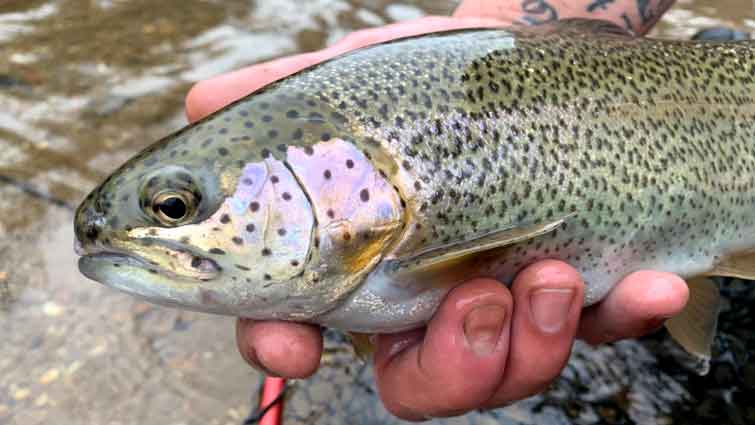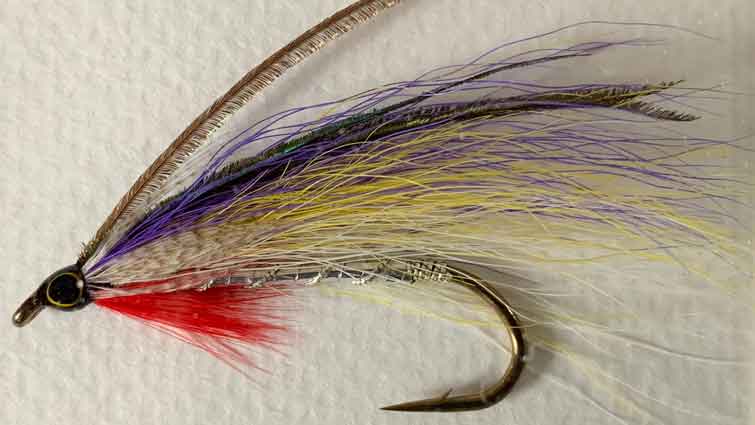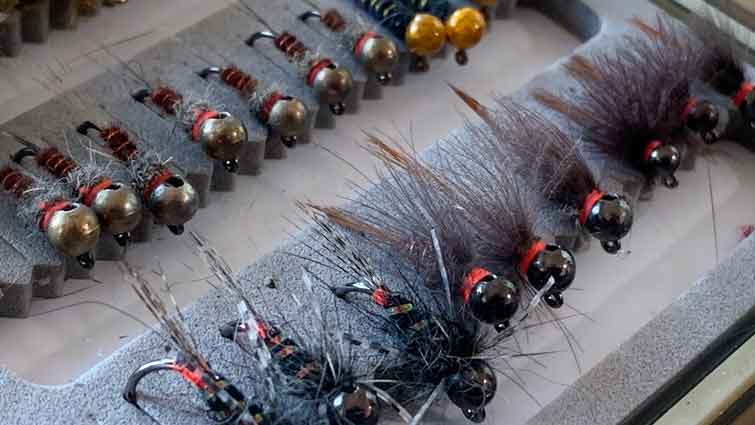Wet flies imitate the larval and nymph stage of aquatic insects, one of the most common stages consumed by fish. Because many different species eat these invertebrates, wet flies have been developed for freshwater and saltwater fishing.
As a general rule wet flies can be made out of various materials, including hair, wool, or feathers. Each material has its benefits and drawbacks regarding how easy it is to tie a pattern with them and what kind of action they produce while being fished. Wet flies are usually fished in riffles, runs, and pools where fish hunt in the feeding zone.
Fish will typically eat both larval insects and nymphs because these two stages are not only abundant in rivers, but they offer different benefits to fish depending on what kind of water they're living in. In this article, we will discuss wet flies and how to fish them.
What Are Wet Flies?
Wet flies were the first artificial patterns ever invented before even hooks existed. The term "wet fly" was derived from the fact that they always used to be tied on a wet-fly hook, an offset shank hook with a large bend in it, and a very thin wire.
Wet flies can be fished just below the surface or underwater, depending on what insect they represent and how they're fished. These may include:
- Caddisflies
- Stoneflies
- Mayflies
- Midges
Wet fly fishing is an effective and exciting way to catch trout, steelhead, and salmon. Also known as sub-surface fishing, this method uses artificial flies placed at the bottom of the water column and are typically swung to the surface representing an emerging or fleeing food source for trout.

Wet flies are categorized based on how they're fished. There are two kinds of wet fly fishing techniques: nymph fly fishing and wet-fly fishing. The difference between these two techniques is the drift and swing on the end of that drift. Fly patterns also are tied differently to mimic these types of retrieves.
How to Fish Wet Flies - Wet Fly Swing
Once rigging is taken care of, we'll move on to some fishing techniques like the famous "wet fly swing." The wet fly swing is used to quickly and effectively bring the fly down deep and swing it in front of the target fish. When trout are holding deep but not rising for any particular hatch, this technique is used by trout anglers.
To perform the wet fly swing:
- The angler must first find an excellent deep run with slow currents.
- The technique is best performed on head-high, low-gradient water so that the fly can be swung across it in an arc to cover as much area as possible.
- Cast the fly slightly upstream and across
- Follow the line through its drift with the rod tip
- Stop moving the rod tip or lift it slightly when you think the fly is close to where a fish should be.
Traditional Nymphing
Traditional nymphing as a wet fly fishing technique is a highly effective method of catching trout. As with most wet fly methods, traditional nymphing can be performed in the spring and fall seasons when terrestrial insects are more abundant, and fish tend to feed on them a lot.
Traditional nymphing revolves around producing a drag-free drift to make the nymphs appear like trout food tumbling down the river. A 9-foot tapered leader is attached to one or two nymphs. When traditional nymphing, 5X or 6X tippet is frequently used.
Once the fly is rigged, it can be swung or cast upstream and stripped back in. The fly should be positioned downstream of where you are standing to get maximum depth with the drift. A bobber stop knot tied to the line about one foot above the fly serves as an indicator on surface nymphing, while a small split shot is used for deep-nymphing techniques.
The movement of water causes natural disturbances that attract fish's attention. For this reason, trout always look for food according to their location - whether near rocks, plants, or logs. Nymph flies imitate these movements making them even more effective.

Tips and Tricks for Wet Fly Fishing
Some of the best tips and tricks for wet fly fishing include
- Consider re-tying your leader material when it starts to get sloppy.
- Remove the fly from the water in a fast, fluid motion.
- It's all about the weight. Wet-fly anglers rarely use split shot, but it's a significant success factor and enables you to cover water that would be off-limits to wet-fly fishers.
There are several different techniques for fishing traditional wet flies. Some technical tips include:
The fly should be cast across and downstream of the area you're trying to fish, then swung into the current like a pendulum until it swings back into your casting position.
Pulling out line as fast as possible is usually best when bringing in the line after every few casts; this also keeps too much weight off your leader material, which can lead to sloppy presentations if not re-tied often enough.
When pulling up all of your slack (without resting), make sure that you do so with an upward motion instead of downward - this ensures a quick, fluid movement without any pauses or slowdowns.
What Does a Wet Fly Look Like?
Wet flies imitate insects that live on or underwater before emerging as adults. They can resemble leeches and crawfish to small fish and other aquatic creatures such as shrimp and dragonfly larvae. These flies should sit low in the water with their hackles upright to mimic an insect swimming at the surface of the water.
Wet fly patterns are 'hackled,' meaning a feather is used as a wing, but there should also be a soft-looking collar made from the same feather to resemble flies that have just hatched.

The biggest difference between wet flies and nymphs is that they are used at different times in the life cycle of trout. Traditional wet flies are only used when there is surface activity taking place--this would include things like duns (the adult stage), spinners, caddisflies, etc. Nymphs are often fished deeper than traditional wet fly patterns and can also be fished under an indicator.
Nymphs should sink vertically - the faster the current, the slower your fly sinks so additional weight is typically needed. This is my favorite type of fishing as you can cover a lot of water and fish specific runs where trout hideout.

How Do You Tell a Wet Fly From a Dry Fly?
Dry flies represent insects that fish feed on that land on top of the water. Wet flies resemble insects that grow and live below the water surface before hatching and floating to the surface. They can also imitate larger creatures such as crawfish, leeches, and smaller fish found in streams and rivers.
Wet flies sit in the water. Dry flies hover above the surface of the water.
They seek out the adult, emerging, and drowned insects. Some of the types available are Emergers, nymphs, streamers, and imitations of hatching insects or other bigger bait.

What's the Difference Between Wet Flies and Nymphs?
In fly fishing, the term nymph refers to an artificial fly that resembles sub-aquatic trout food in its pre-adult or larval phase. Nymphs are designed to resemble immature (typically aquatic) insects in their pre-adult or larval stage.
Wet flies resemble newly emerged insects, and nymphs mimic fledgling larvae crawling on the bottom. Wet flies are nymphs because they both sink.
Nymphing simply means fishing using nymphs, which are in the water. Practice both casting and catching practice in a place without current before you finalize your choice of nymphing or dry fly fishing.
The biggest difference between wet flies and nymphs is that they are used at different times in the life cycle of trout. Traditional wet flies are only used when there is surface activity taking place--this would include:
- Mayflies
- Spinners
- Caddisflies, and more!
Nymphs are often fished deeper than traditional wet fly patterns and can also be fished under an indicator, just like dry flies.

Is a Nymph a Wet Fly?
While nymphs are a type of wet fly pattern, they have a different purpose in fishing. A wet fly is fished on the upper water column and moves with the current to catch a fish's attention, while a nymph is fished deeper in the water column and moves with the currents natural movements to entice fish into biting.
Nymphs are a type of wet fly. Wet flies, or sunken flies, represent insects that live underwater before emerging as adults. Nymphs are tied to sink in the water and represent a different life stage of the insect life cycle than traditional dry flies.
Nymphing is when you fish with nymphs (a type of wet fly). Nymphing is done in a fast current where trout feed on developing pupae and larvae before hatching into adult mayflies, caddisflies, stoneflies, etc.

How Do You Rig a Wet Fly?
When rigging wet flies, you tie them to your line using a loop knot or an improved clinch knot. This ensures that the fly will ride high in the water column and does not get tangled up on its own leader material, making for easy casting.
To rig a wet fly, use a tapered leader the same length as your fly rod. Then attach 3ft of 5x or 6 x tippet to your leader using a double surgeon's knot. Then attach the tippet to the eye at the base of the fly's hackle with an improved clinch knot.
What Are Wet Flies Used for?
A wet fly is fished on the surface and moves with the current to catch a fish's attention, while a nymph is fished deeper in the water column and moves with the currents natural movements to entice fish into biting. Nymphs are often fished under an indicator or diffused shot for this purpose.
Wet flies are meant to be presented to fish near the surface of the water. Wet fly patterns frequently include a weighted component to assist the fly sink further in the water column. A "bead head" is what it's called. The bead serves as a weight so that the insect may sink more quickly in the water column.

When using a wet fly, fish the fly just under the surface of a stream. The current should carry your fly, giving it a life-like appearance as if swimming on its own. Wet flies resemble insects that live underwater before emerging as adults. Nymphs are tied to sink in the water and represent a different life stage of an insect's developmental cycle than traditional dry flies.
Wet flies imitate insects that live on or underwater for some time before emerging as adults. There is only one season when trout go after them: right before and during their hatch of an insect. During this time, trout will chase and hit your fly viciously, so take advantage when you see fish chasing frantically below you!
Wet flies are a type of fly used to catch fish. These flies imitate the larval and nymph stage of aquatic insects, which is one of the most common stages consumed by fish. Because many different species eat these invertebrates, wet flies have been developed for freshwater and saltwater fishing.
Wet flies can be made out of various materials, including hair, wool, or feathers, for example. Each material has its benefits and drawbacks in terms of how easy it is to tie a pattern with them and what kind of action they produce while being fished. Wet flies can be made from various materials, each with its benefits and drawbacks. The type of fly you choose to use will depend on the species you are trying to catch as well as what your fishing style is like.






